Up to the Task
Four members of Shelburne’s Anti-Black Racism, Anti-Racism and Discrimination Task Force discuss their mission and the vision they have for Shelburne.
As Alethia O’Hara-Stephenson and Althea Casamento wrapped up their online Anti-Black Racism, Anti-Racism and Discrimination Task Force presentation to Shelburne town council the evening of October 5, their closing slide was a fitting coda to an intense process that had started in June.
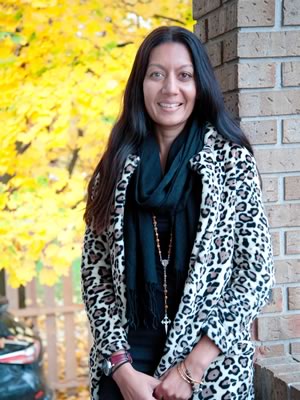
Task force member Althea Casamento. Photo by Rosemary Hasner / Black Dog Creative Arts.
A photo showed the town’s diverse, peaceful – joyful, even – Black Lives Matter march on June 14. The task force had already been proposed by then, fuelled by a global sense of urgency about anti-Black racism. But for those who believe Shelburne can do better by its growing number of Black, Indigenous and minority citizens (in total, about 20 per cent of the town’s total population), the march affirmed that they were on the right side of history.
“You gotta pinch yourself – it was a moment,” said Deputy Mayor Steve Anderson, recalling how it felt to look back at the crowd from where he was walking with Mayor Wade Mills. “This is really happening. I knew we had a mandate.”
Anderson made the initial motion to council to establish the task force on June 8. Alethia O’Hara-Stephenson was named chair and the 14-person task force held its first meeting June 19. The group’s recommendations to the town include antiracism and “diversity, equity and inclusion” (DEI) training, regular equity audits, and grants for BIPOC (Black, Indigenous and people of colour) youth programs.
“It was amazing to see such a diverse group of individuals come together to work on a collective goal with town council,” says O’Hara-Stephenson. “That is a testament to the power of working together for the greater good.”
Not only has the town accepted the recommendations, but officials from other jurisdictions and organizations have asked for the report to study – including Headwaters Communities in Action, Dufferin County, Nipissing University and the City of Brampton. In late October Dufferin County also announced the members of its first Diversity, Equity and Inclusion Community Advisory Committee.
That key blueprints for institutional change are coming from a small rural town north of Toronto, one often perceived as very conservative, is a point of pride for Anderson. “If you got the press release from Brampton or Toronto, that makes sense,” he says. “But for a rural town to be leading the charge? It takes people to lead by example and it takes large parts of the community buying in. People are now standing and taking note about the great work we are doing in the town of Shelburne to make our community safe, prosperous and welcoming to all.”
We asked four task force members – chair O’Hara-Stephenson, who works in business continuity management in the financial services industry; vice-chair Casamento, the director of Orangeville’s Choices Youth Shelter; secretary Geer Harvey, a social worker at Centre Dufferin District High School; and Soha Soliman, a Grade 10 student at CDDHS – to join us for an email roundtable.
Tralee Pearce : How profound a catalyst was George Floyd’s death to the formation of the task force? Black Lives Matter has been protesting since 2013. Why was this the right moment for Shelburne?
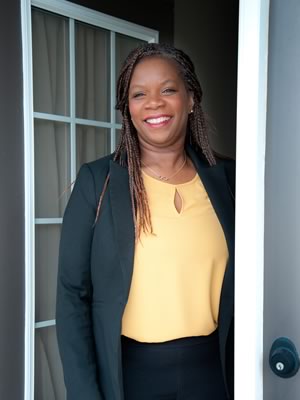
Task force member Alethia O’Hara-Stephenson. Photo by Rosemary Hasner / Black Dog Creative Arts.
Alethia O’Hara-Stephenson : This was already a very difficult year for the Black community with so many affected by Covid-19. When Ahmaud Arbery was murdered, it was traumatic. When Breonna Taylor was murdered, it was yet another traumatic situation. When George Floyd was murdered, this was the catalyst for change. When the video was circulating, I didn’t want to watch it, but I finally did and it was painful. When George cried out for his mom, my heart ached. In that moment I saw my sons, I saw my dad, I saw my uncles, my brothers, my friends.
When George’s lifeless body was on the stretcher and there was no attempt to revive him, it was as if his life was of no value – no different than hauling out the trash. It wasn’t just some person, this was my pain. I felt it. This is what critical race theorist William Smith calls “racial battle fatigue.” I cried for a week. I was disappointed in the world and disappointed in myself for not doing more.
The exposure to all of these murders, the daily micro aggressions faced by the BIPOC community and my lived experiences are all very exhausting and traumatic. We could not turn off those feelings.
After a week of mourning and healing, I got up and started to act. I reached out to our leaders asking each and every one of them what they were going to do to make sure our community is safe. These issues of racism and discrimination are not unique to the United States.
No longer could the world pretend these murders weren’t happening. The Black community was already heavily taxed mentally, physically and emotionally. And you have the world on lockdown with so many home from work and school. This was the perfect environment for individuals to take a stand.
If you noticed, most of the BLM marches were led by young people – and here in Dufferin County by young women. You have young, intelligent and strong leaders who had had enough and were no longer willing to accept the status quo.
Geer Harvey : It was like the world woke up to what Black people have been saying for a long time about institutional, structural and interpersonal racism.
The Ahmaud Arbery, Amy Cooper and George Floyd events created the perfect storm. With Amy Cooper (a Canadian), the world got to see how white privilege is weaponized to harm Black people. With Ahmaud Arbery, they got to see a modern day example of a lynching. With George Floyd, the world got to see the indifference to the lives of Black people. Correction: The world got to see it and they believed it this time.
This was the time for Shelburne to take stock because the growth in population in the last census reflected an increase in the number of BIPOC in the town. And because racism exists. It was the right time for town council to add their voice to this global movement and say we acknowledge that racism exists and we want to do better. Part of being antiracist means you use your voice to speak up against injustice. Taking action in this movement is a tangible way to demonstrate you care, a tangible way of acknowledging BIPOC humanity.
Soha Soliman : The death of George Floyd hit everyone in the heart. White people do not walk out of their house with the fear they will be treated differently and killed because of something they can’t control. But Black people do.
This always seemed scary and big – too much of a task for such a small town as Shelburne to tackle. But seeing that video and realizing that change, justice, equality and equity has to reach every corner of the world, passionate and determined leaders in our community held hands to make our town feel like home for people of all races, religions, genders, cultures and faiths.
Althea Casamento : The global reaction to George Floyd’s death was profound because it was the first incident I know of that was very public. The entire world could feel what happened to him. It gave credibility to what the BIPOC community has been saying for years. There was no more denying we are treated differently.
Like the majority of the world who saw the video, my heart broke. I was angry! I reached out to another community leader to discuss what I had seen. I remember saying, “What are we going to do? We can’t just let this go.”
This was the “right moment for Shelburne.” I added the quotes because many of Shelburne’s BIPOC community leaders have long been working hard on creating change and educating others about the injustice we face. We as a community couldn’t accept this.
TP : The task force gathered information in a survey, a focus group and in presentations from local groups. There were examples of racial profiling, harassment and a lack of diversity in institutions. What stories stood out?
AO : There were several stories that stood out for me but the most profound was hearing the story of someone requiring medical care refusing care because the person providing care was from the BIPOC community. This level of ignorance just blew my mind. I could not and still can’t comprehend this.
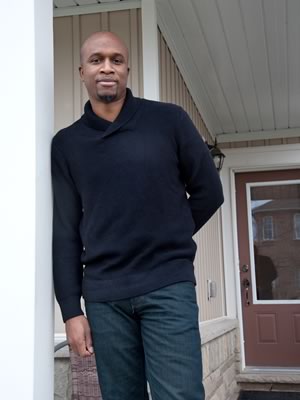
Task force member Geer Harvey. Photo by Rosemary Hasner / Black Dog Creative Arts.
GH : There was one story that stuck out for me and it highlighted how George Floyd’s death made being racist intolerable. There is a man in town who called out racism in a very public way and the backlash he received was incredible. It was a textbook case of the struggle that white people have talking about race. (See Robin DiAngelo’s book, White Fragility.) I wonder if this man would have received more empathy post George Floyd. This current movement for racial justice provides white people with an opportunity to do better. It provides us as a community a chance to grow.
AC : Many of the presentations from community members and agencies further supported what many were saying for years. This was just a formal way of capturing the data. Many stated they tried to bring forward complaints or requests for support but were not being heard.
SS : It was actually my own story which drove my work. At my elementary school, I was continually harassed and bullied for my hijab and being of a different ethnicity and race. One day the same group of boys followed me and my friend when we walked home and tried to pull off my hijab. This experience was traumatic and will forever haunt me as I walk around with the fear that a piece of my faith can be snatched off me in a second.
TP : You made specific recommendations to the Upper Grand District School Board, including asking for a more transparent complaint process and more diversity among staff. Geer, as a school social worker, and Soha, as a student, can you tell us more? Is there a sense that what happens at school is hidden from the rest of us in the community?
SS : What happens at our school is hidden from the rest of the community. People inside the school, especially the ones who should know, such as the principal, are not aware of what happens in their school. When they are told their reaction is always “Wow, really?” and “I never knew that could happen” and “Are you sure that’s what happened to you?”
They do not want a reputation of tolerance for racism and discrimination against BIPOC students but have not been educating students’ parents and families.
When I speak to members of the community, they say they thought their town was very diverse and inclusive and a place people would feel proud to call home. But that isn’t the case for many, including me. What happens at school is so crucial because it seriously affects mental health, academic performance and overall outlook. Students feel that teachers treat them differently because they look different. They may not feel like even continuing with their work anymore, leading to bad grades and increased stress levels.
I want my school to feel like a second home when I walk in. I do not want to feel stressed, degraded and judged for who I am. I should be able to carry myself with pride and peace.
GH : Those who have children in the system know the stories. The recommendation for transparency in complaint procedures is about seeking accountability. One of the resounding themes I heard in the focus group was the need to know the next step. The civil rights movement taught us many things, one of which is that institutions need to be held accountable for the lip service they offer. Asking for transparency in the complaint procedure is about students knowing they can trust their concerns can be followed up on.
AO : Geer’s points around accountability are critical because the school is where our future leaders are being moulded and shaped. When the concerns, opinions and incidents of discrimination of our students are dismissed or not addressed, it forms their views of the world around them – and further feeds into the system that is designed with barriers in place.
What gets tracked and measured gets done.
Likewise representation in our schools matters. Students need to be able to envision a future of possibilities and that can only occur when they can see themselves in the role of teacher, for example.
TP : The recommendations start with short-term goals, such as creating safe spaces and times for people to talk about these issues, and encouraging the use of local or historic BIPOC names when new streets need naming. Do you see these as quick wins? Do they help build momentum for bigger asks?
SS : No, I don’t see this as a quick win. This will be the first step to some bigger tasks. A street named after a person from the BIPOC community remains in our town forever. After driving the street, people may be interested in looking up the name. They will learn about the work the BIPOC community has done and how that will affect or has affected their lives. I like to think of it as a form of education, breaking some stereotypes and ignorance. As Nelson Mandela once said, “Education is the most powerful weapon which you can use to change the world.”
Even if a safe space is not established physically, it can be established emotionally and mentally. It will help many on their worst days, allowing them to talk to people who look like them, feel like them, hear like them, see like them and experience like them so they know they aren’t alone.
GH : Part of this BLM moment is correcting where we have gone wrong.
The naming of public spaces is low-hanging fruit, a tangible step the town can take. It also requires some acknowledgment of the land we are on and the ignored contributions of BIPOC people. I wish I had a better word but our history and culture as Canadians have been whitewashed, with the story of white contributors being the only story that we have heard. Consider that the two official languages of Canada are English and French – how is that possible when there were people here before the settlers? (I recognize Indigenous peoples have many languages.)
AO : I am hesitant to use the words quick win because I don’t want to take away from the impact of such a change. However, these are small steps towards recognizing our diversity, celebrating our uniqueness and moving towards more structural change. The visual impact will also instil a sense of pride, especially in our youth who will be reminded of the value and contributions of people who look like them.
AC : I am also hoping if the safe spaces are used appropriately, they will inspire even more ideas and action. I think all of this will ultimately lead to a community that is supportive of its community members. I don’t believe in quick wins. Everything takes time and effort.
TP : And now the biggest ask: that council hire a Diversity, Equity and Inclusion staff member, which many other Canadian municipalities have. Why is this a necessary step to tackle systemic racism? Is it in part because it begins to change who is inside that system?
AO : Hiring a Diversity, Equity and Inclusion person is not about changing who is on the inside but ensures that there is a permanent diversity and equity lens on all systems and processes. Many organizations are reacting to the murder of George Floyd by putting out statements of support, but statements alone cannot change centuries-old structures.
By hiring a DEI person, we will be able to focus on many of the task force’s recommendations, short term and long term. They will look at things like hiring practices, ensuring the language used doesn’t automatically discriminate. The town can extend the reach of their recruiting strategies to target a diverse talent pool – therefore getting the best talent to grow our community. Finally this individual can help facilitate training for staff and update policies with a DEI focus to ensure that policies don’t act as barriers to access and opportunity.
This will not be an easy role, but it is a critical role in creating a community that will be diverse and inclusive for all.
TP : Althea, since 2018, you have been bringing the community together for Multicultural Day to celebrate the many cultures represented in the town. You have already voted for a neighbourly approach. Are you optimistic that Shelburne could be poised to set an example for other communities like it?
AC : I would say Shelburne is already setting an example for many other communities. We just needed to get through the initial growing phase that every community goes through when there has been a drastic increase in population and demographics over a short time. Our community as a whole is very welcoming.
This roundtable has been edited and condensed.
More Info
The full list of the Town of Shelburne’s Anti-Black Racism, Anti-Racism and Discrimination Task Force members:
- Wade Mills, Mayor
- Steve Anderson, Deputy Mayor
- Alethia O’Hara-Stephenson, Chair
- Althea Casamento, Vice Chair
- Geer Harvey, Secretary
- Simran Bhamu
- Bella Carter
- Nathan King
- Kent Moore, Police Chief
- Ken Topping
- Shyanne Ricci
- Debbie Sipkema
- Soha Soliman
- Jay Wagstaff
Resources:
- The task force’s October 5, 2020 presentation:
https://www.shelburne.ca/en/living-here/resources/Documents/Blue-Print-final.pdf - The Dufferin Diversity Equity and Inclusion Community Advisor Committee (DEICAC):
https://www.dufferincounty.ca/news/diversity-equity-and-inclusion-community-advisory-committee - The Dufferin County Canadian Black Association (DCCBA):
https://dufferincountycba.org/
Related Stories
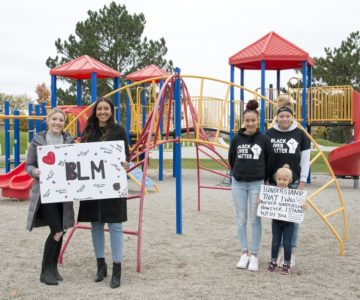
The New Hope: Local Black Lives Matter Organizers
Nov 24, 2020 | | Local HeroesThese four young women (plus one younger sister) were the moving force behind two crucial local social justice marches – one in Orangeville and one in Shelburne.
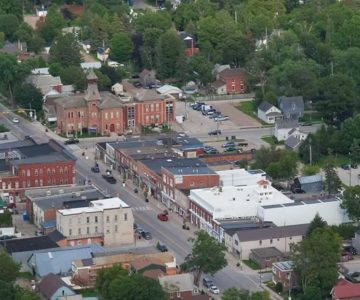
Shelburne: A Town in Transition
Sep 16, 2017 | | CommunityAccording to Statistics Canada, Shelburne is Ontario’s fastest-growing town – and for residents old and new, that’s mostly a good thing.
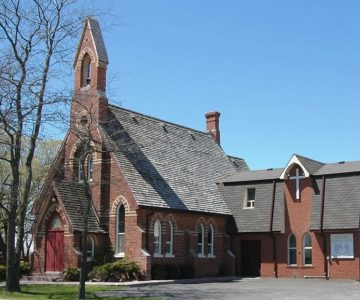
Making Black History in Caledon
Mar 24, 2020 | | HeritageA new museum exhibit called Our Voices, Our Journeys celebrates local black history through the personal stories of a Caledon congregation’s pioneering contributions to Headwaters.
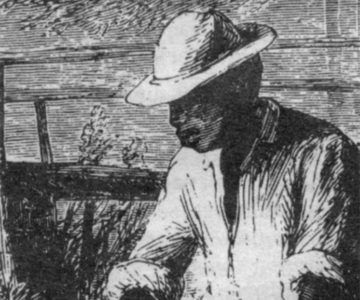
African Shadows
Nov 19, 1998 | | HeritageBlack settlers were among the first homesteaders in the hills, but little of their legacy remains.










